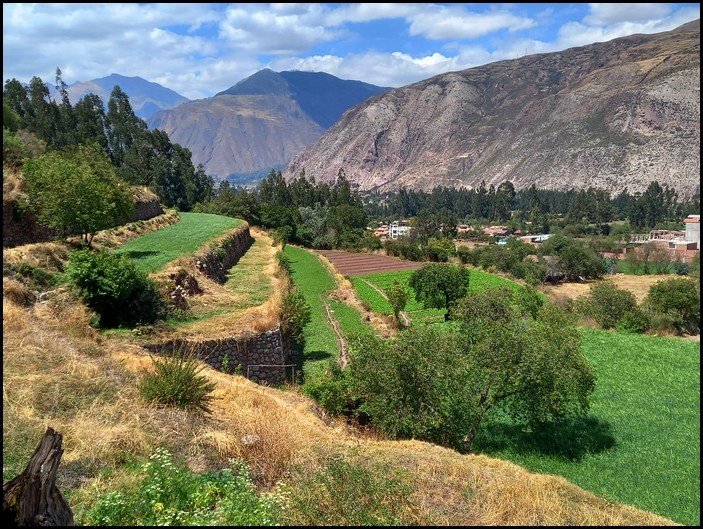
Introduction to the Spectacular Sacred Valley Peru
The Sacred Valley of Peru is a long, narrow and winding, high-altitude valley that follows the course of the Urubamba River. The picturesque valley is tightly hemmed in by a series of soaring, over-lapping mountain ridges and peaks.
The full name of the beautiful, fertile valley is ‘Sacred Valley of the Incas’. In Spanish, that’s ‘Valle Sagrado de los Incas’. In Quechuan, the original language of the Incas, it’s called ‘Willka Qhichwa’.
It’s also known as Urubamba River Valley. The wide, fast-flowing river running through this long section of its valley is also considered sacred by the Incas.

Location of the Sacred Valley
The Sacred Valley is located in Peru’s high southeastern Andes Mountains, just north of historic UNESCO city, Cusco. The valley is oriented southeast to northwest and runs for over 70 km / 45 miles between the tiny village of San Salvador in the east and historic Inca town of Ollantaytambo in the west.
In reality, the Sacred Valley continues considerably further west from Ollantaytambo, following the Urubamba River all the way to Aquas Calientes, a small tourist hub at the base of Machu Pichu mountain.
The section of valley between Ollantaytambo and Aquas Calientes nearly doubles the length of the Sacred Valley. And, of course, the river valley continues westward beyond Aquas CAlientes as well.
However, the official ‘Sacred Valley’ section of the Urubamba River Valley is generally considered to run between Pisac (close to San Salvador) and Ollantaytambo. It was at Pisac, Ollayntaytambo and the valley between these two original Inca towns where the Incas built high mountainside towns & religious sites, superb stone-terraces fields, Imperial houses.
The fertile Sacred Valley between these two towns is also where the Incas produced an abundance of corn, various potatoes & root crops, and other vegetables and fruits to sustain their ever-expanding empire, especially in the 1400s to early 1500s.
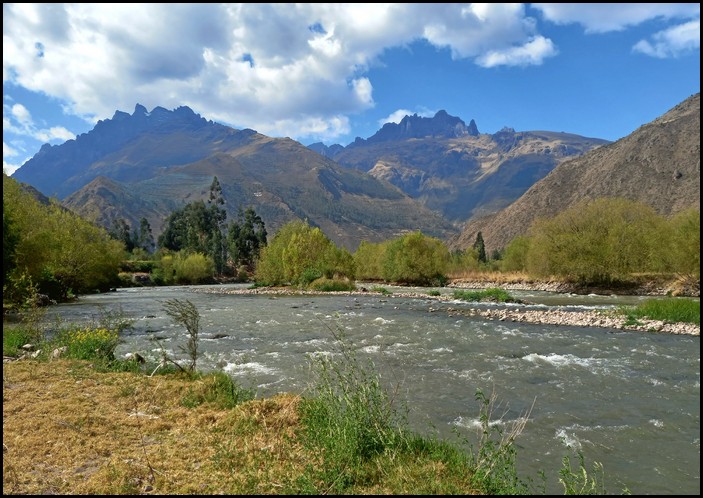
Geography and Topography of Sacred Valley
The floor of the scenic valley is more or less flat. It’s blessed with very fertile soil, an abundance of fresh water and a mild, year-round even climate. All of this allows for great agricultural production.
The narrow valley floor stretches only 0.5-1 km across (0.3-0.7 of a mile), with the wide, fast-flowing Urubamba River running through the middle. The river flows from southeast to northwest.
The elevation of the valley floor slopes gradually downhill from 2995 M / 9826 ft at San Salvador to Ollantaytambo at 2792 M / 9327 ft. From Ollantaytambo the river valley turns more westward, becomes considerably more narrow and drops more dramatically in elevation to Aquas Calientes at 2040 M / 6690 ft.
Eventhough most of the valley floor rests at over 2700 M / 9000 ft, the mountains surrounding it are considerably higher. Most reach close to 4000 M / over 13,000 ft, while a few moutains top at over 5800 M / 19.000 ft.
The panoramic, soaring mountains consist of a huge variety of terrains and natural features. There are steep near-vertical mountainsides, prominent rock outcroppings, huge vertical cliffs, jagged mountain tops, patches of eucalyptus and pine forests, plunging waterfalls and a mix of soil & rock colors, including reds, greens, browns, beiges and whites.
The ultra-steep mountain slopes also feature multi-level rock-terraces, zig-zagging walking paths, Inca ruins and small traditional communities nestled at their bases.
Many other valleys and rivers flow into the Urubamba Valley from both sides, adding layers of seemingly over-lapping mountains, contours and scenic views.
Several even higher mountains rise way up beyond the nearest mountain ridges. The super-jagged peaks of Mt. Pachatusan soar above San Salvador village up to a whopping 4850 M / 16,005 ft. Its multiple rocky peaks are covered in snow most of the year.
Several even higher, snow-capped jagged mountains rear their peaks just north of Urubamba. The ultimate highest is Mt. Sahuasiray, rising up to 5818 M / over 19,000 ft. Neighoring Mt. Chicon reaches 5530 M / 18,240 ft., while Mt Capacsaya peaks at 5044 M / 16,645 ft.
These incredible mountains are mostly hidden from view at the valley floor, but their jagged snowy peaks can be glimpsed from Urubamba, or more clearly by taking a small mountain road up from Urubamba.
Needless to say, the Sacred Valley, with its fertile fields, steep terraced mountainsides and dramatic ultra-high mountains, is a beautiful slice of the world.
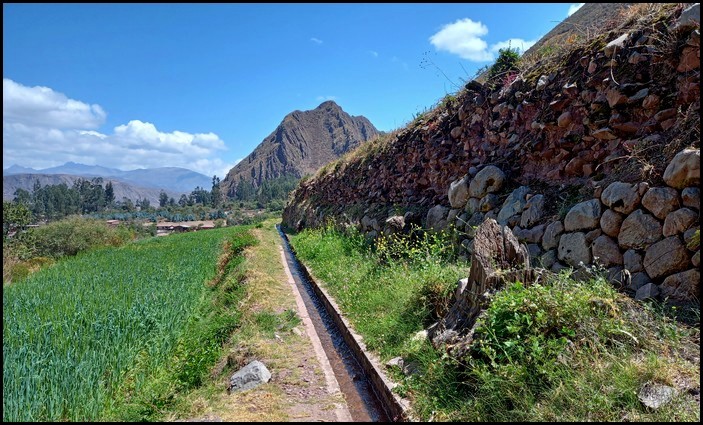
Climate of Sacred Valley
Despite the valley’s high altitude of over 2700 M / 9000 ft, the Sacred Valley has a surprisingly mild climate year-round. That’s due to its fairly-close proximity to the Equator. The valley is situated at Latitude 13° South.
Its latitude creates year-round mild day-time temperatures between 16-25 C / mid-60s to mid 70s F. Night-time temperatures dip to between 5-10 C / 40-50 F, year-round.
The big temperature differences between day and night are due to the valley’s super dry climate. Humidity in dry season hovers around 40-50%.
Rather than temperature, seasonal differences in Sacred Valley are due to rain or lack thereof. Two clear seasons exist: dry season, from May through September, and rainy season, from October through April.
Dry season brings spectacular early-summer like weather to Sacred Valley. Bright blue skies and intense sun make the temperatures feel considerably warmer than their technical temps of 17-25 C / mid-60s to 70s F. Often times in midday, some vistiors might call the weather hot and pull out their short-sleeved summer clothes.
In great contrast, the long six-month rainy season brings mostly cloudy skies, torrents of rain and strong winds. Despite officially having nearly the same temperatures as dry season, it feels considerably colder Math the lack of sun and all the chilly rain and wind.
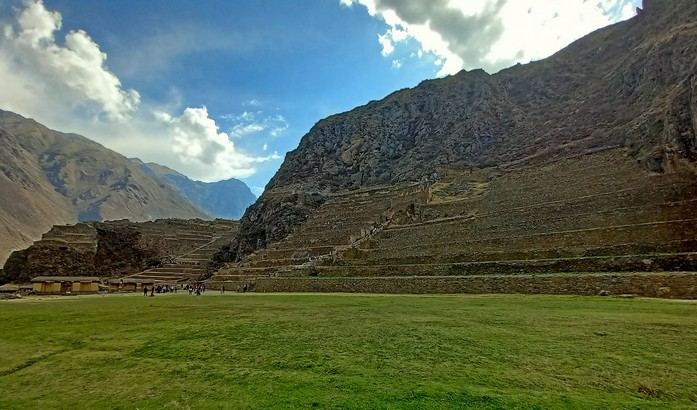
Brief History of Sacred Valley
The Sacred Valley is famous for its Incan history. But before the Incas settled in the Urubamba River Valley, several other lesser-known tribes made the valley home.
Going as far back as 800 BC, the Chanapata civilization used the rich river valley for agriculture. They were followed much later by the Qotacalla peoples and then the Killke tribe, who resided there from about 900 AD until the Incas took over.
The Incas were in the Cusco area from the 1100s, living alongside other tribes. They gradually expanded into and through the Urubamba River Valley during the course of over 400 years, from the 1100s to the 1400s.
By the 1400s, the Incas had taken over the valley completely, while their capital city remained in nearby Cusco. They used the valley to grow produce for their ever-expanding empire, as well as to build high-mountain religious sites and towns.
Unfortuantely for the Incas, their vast and glorious empire was brought to a screeching halt by the Spanish conquistadors in the early 1500s. Their capital at Cusco and holdings in the Sacred Valley were quickly over-run by the invaders.

Inca Archaeological Sites in Sacred Valley
As noted above, nowadays there are many Inca ruins within the Sacred Valley. They range from huge, impressive former cities and religious sites to minor ruins, and a plethora of stone walls and canals.
The three most extensive and important Inca sites are those at Machu Pichu, Ollantaytambo and Pisac.
Of course Machu Pichu is known all over the world as one of the great man-made wonders of the planet. But the lesser-known sites at Ollantaytambo and Pisac are nearly as large and impressive as the more famed site.
All three Inca sites were constructed very very high up on steeply-sloping mountains, over-looking the vast valleys below and neighboring mountains.
Pisac is a small historic town, set along Urubamba River, near the eastern limits of Sacred Valley. It’s a 45-60 minute bus or car trip from either Urubamba or Cusco.
Just above Pisac town are a series of steep stone Inca terraces, but the main Pisac Inca site is located much higher up a steep winding mountain road. To visit, tourists must have purchased one of the offered ‘Tourist Package Tickets’. There’s no single / separate entrance ticket to visit only Pisca ruins.
The same holds true for entrance to Ollayntaytambo ruins. However, at Ollantaytambo, the Inca’s steep and extensive stone terraces and buildings are situated right on the edge of town. They are clear to see from any point in/near town.
Just on the other side of town are two smaller Inca sites. They’re also set high on a very steep mountainside and can be seen from town. But it’s free to high up to these minor, but impressive sites. And views from there over Ollantaytambo, the adjacent lush valleys, and the major Inca site are superb.
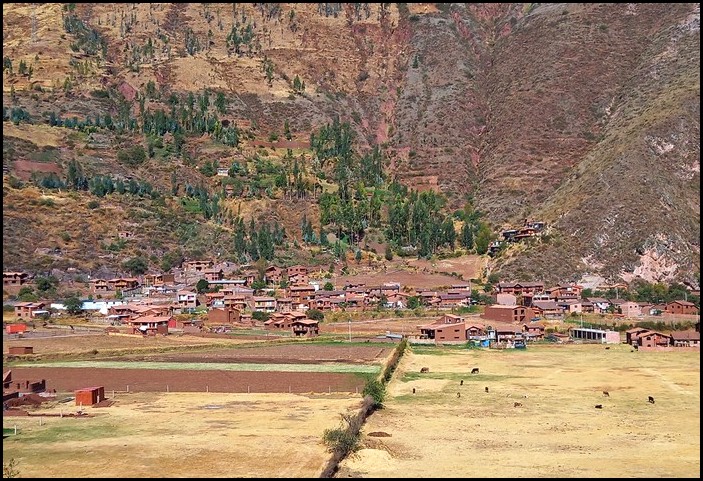
Sacred Valley Today
Nowadays, Sacred Valley is one of the most highly visited places in Peru. That’s in great part due to the fact that all visitors must travel through Sacred Valley to reach Machu Pichu, Peru’s premiere tourist attraction.
However, travelers also visit Sacred Valley to explore various other important, beautiful and intriguing sites within Sacred Valley, as noted above.
Besides the many Inca archaeological sites, there’s Maras salt mines and the intact original Inca town of Ollantaytambo, with its narrow cobblestone sidewalks and sturdy stone & stucco homes and shops. Incan-built stone walls, terraced fields and plethora of stone canals are scattered about the valley and towns.
Stretching from San Salvador in the east to Ollantaytambo in the west, there are several small towns, clusters of homes and plentiful fields occupying the valley. In the center of it all is the wide and fast-flowing Urubamba River.
Each town and community has its own vibe, architecture and types of residents.
Pisac still has many cobblestone streets lined by various colonial-style buildings. The town has become a hub for bohemian types into yoga, meditation, healthy living, hiking and vegetarian food. There are several hip cafes and vegan restaurants in town.
Many very luxurious but low-key resorts and hotels are also scattered throughout the valley. In addition, many Europeans and Americans have made their homes in Sacred Valley, often owning restaurants, cafes, shops or resorts.
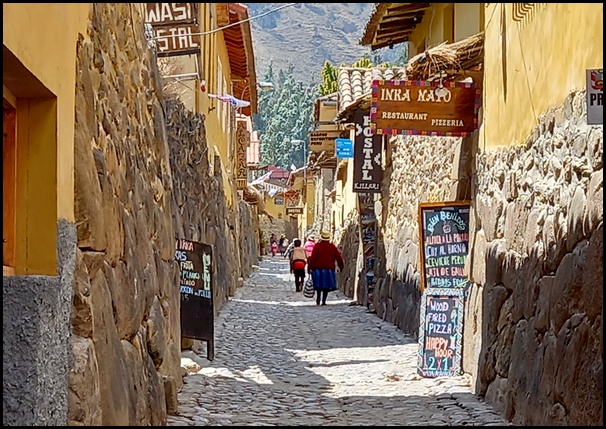
Besides visiting impressive Inca ruins, quaint towns like Ollantaytambo and Moray salt mines, the Sacred Valley is a wonderful place to simply going hiking. It’s easy to hike along Urubamba River, or along narrow stone canals on the flanks of the mountinas, or up into the mountains and side valleys.
Quite wonderfully, and a bit surprisingly, the Sacred Valley is still quite undeveloped or marred by tourism. Despite the scattered luxury resorts and thousands of tourists passing through, the valley is still a very tranquil, mostly rural and overwhelmingly ‘au naturale’ experience.
Another great treat for visitors is the fact that many, many Incas still live in the valley. They go about their daily lives, dressed in their tradtional Inca clothing. Anyone visiting the valley will see them in every town, on local buses, in fields and mountain paths. They’re a solid presence in the Sacred Valley.
=============================
You might also enjoy:
12 Interesting Facts about Peru
=========================







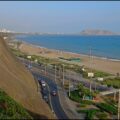
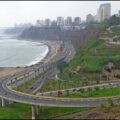
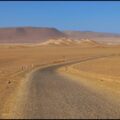


 Hi! I'm Lash, an American nomadic world traveler who's been traveling solo since 1998. I’m passionate about traveling the world nomadically and then sharing it all with you. I hope to inspire you to travel the world, to entertain you with tales from the road, and to help you reach your travel dreams. Welcome!
Hi! I'm Lash, an American nomadic world traveler who's been traveling solo since 1998. I’m passionate about traveling the world nomadically and then sharing it all with you. I hope to inspire you to travel the world, to entertain you with tales from the road, and to help you reach your travel dreams. Welcome! 




3 pings
Surviving the Cold Unheated Guesthouses and Hotels of South America - LashWorldTour
2022/09/13 at 10:34 pm (UTC 8) Link to this comment
[…] « Introduction to the Spectacular Sacred Valley -Peru […]
The Full Machu Pichu Experience - LashWorldTour
2022/10/19 at 5:48 am (UTC 8) Link to this comment
[…] Introduction to the Amazing Sacred Valley of the Incas […]
35 Highlights of my South American Journeys - LashWorldTour
2024/01/23 at 1:24 am (UTC 8) Link to this comment
[…] one hour’s drive from Cusco is the beautiful Sacred Valley. Historically, it was a major base for the Inca […]